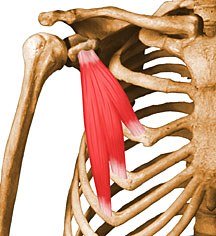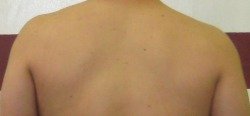Pectoralis Minor

The Pectoralis Minor is an interesting little muscle. "Pectoralis" refers to the chest and "Minor" refers to under. So, the Pectoralis Minor is located under the Pectoralis Major muscle of the chest. It begins at a bony point called the coracoid process which is a hook-shaped protuberance of the shoulder blade that extends forward to the front of the body. The bottom of the pec-minor is attached in three finger-like muscle groups to the third, fourth and fifth ribs.
Pectoralis Minor Muscle and The Shoulder Blades
The Pectoralis Minor has a dynamic relationship with the muscles that move the shoulder blades. When it contracts, the pec-minor muscle pulls the shoulder blade forward and down in the front of the body, creating a round-shoulder type of posture.
This posture often goes hand-in-hand with a slouched and forward-head posture as well. You can tell this is happening when you see the bottom edge of the shoulder blade pop out in the back of the body. Once this posture becomes chronic, not only is the pec-minor affected, but also all the muscles that support and move the shoulder blades as well.

Take a look at the above photo. Notice that the left shoulder blade is elevated and has a shadow around the bottom border, indicating that the shoulder blade has popped out and away from the ribcage on the left. This is a good indication that the left pectoralis minor muscle is tight, pulling the shoulder blade up and forward. Also note that the left shoulder is higher in reference to the right. Compare where the two shoulders fall in relation to the dark line in front of this man's body.
Pectoralis Minor Muscle and Thoracic Outlet Syndrome
The Pectoralis Minor muscle is especially problematic in Thoracic Outlet Syndrome because the brachial plexus of nerves as well as the main arteries and veins that supply the arm pass right underneath the muscle. If the pec-minor is tight, it can compress all of these structures against the ribcage, causing the nerves to be over-stimulated and the blood vessels to be constricted which interferes with circulation.
When there is chronic tension in the upper chest, the pec-minor, nerves, blood vessels and the costo-clavicular fascia (the sheet of fascia that serves the ribs and collarbone) can all become bonded together. This has the potential to make the chest feel tight, compressed, and like it's caving in at the front of the body. Breathing can be depressed as a result as well. This, in turn, will tend to cause the shoulder blades to become bonded to the ribs at the back of the body and can affect the ability of the arm to move fully through its entire range of motion.
Such a little muscle. So many problems that can be caused by it!
Learn more by visiting the following links:
Click the block below that most closely matches your injury for more information and to find the Toolkit we offer to help you in your recovery.







